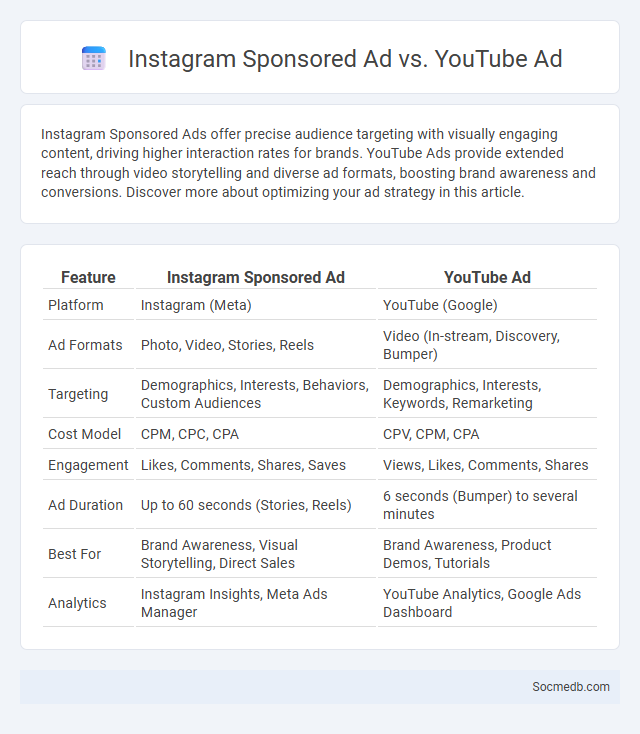
Photo illustration: Instagram Sponsored Ad vs YouTube Ad
Instagram Sponsored Ads offer precise audience targeting with visually engaging content, driving higher interaction rates for brands. YouTube Ads provide extended reach through video storytelling and diverse ad formats, boosting brand awareness and conversions. Discover more about optimizing your ad strategy in this article.
Table of Comparison
| Feature | Instagram Sponsored Ad | YouTube Ad |
|---|---|---|
| Platform | Instagram (Meta) | YouTube (Google) |
| Ad Formats | Photo, Video, Stories, Reels | Video (In-stream, Discovery, Bumper) |
| Targeting | Demographics, Interests, Behaviors, Custom Audiences | Demographics, Interests, Keywords, Remarketing |
| Cost Model | CPM, CPC, CPA | CPV, CPM, CPA |
| Engagement | Likes, Comments, Shares, Saves | Views, Likes, Comments, Shares |
| Ad Duration | Up to 60 seconds (Stories, Reels) | 6 seconds (Bumper) to several minutes |
| Best For | Brand Awareness, Visual Storytelling, Direct Sales | Brand Awareness, Product Demos, Tutorials |
| Analytics | Instagram Insights, Meta Ads Manager | YouTube Analytics, Google Ads Dashboard |
Overview of Sponsored Ads in Digital Marketing
Sponsored ads in digital marketing leverage platforms like Facebook, Instagram, and Twitter to target specific audiences based on demographics, interests, and online behavior. These paid promotions drive engagement, increase brand visibility, and boost conversions through formats such as carousel ads, video ads, and story ads. Data analytics tools help marketers optimize ad performance by tracking click-through rates, impressions, and ROI for continuous campaign improvements.
Instagram Sponsored Ads: Features and Target Audience
Instagram Sponsored Ads offer advanced targeting features, including demographic filters, interests, behaviors, and location, enabling precise audience segmentation. These ads support multiple formats such as photo, video, carousel, and Stories, maximizing engagement through visually appealing content tailored for diverse user preferences. Your campaign can reach users aged 18-34, who represent the platform's most active demographic, ensuring optimized visibility and interaction with your brand.
YouTube Ads: Formats and Audience Engagement
YouTube Ads offer diverse formats including skippable in-stream, non-skippable, bumper, and display ads, each designed to capture attention effectively. These formats maximize audience engagement by allowing personalized targeting based on demographics, interests, and viewing behavior, ensuring Your message reaches the right viewers at the right time. Optimizing ad creativity and placement on YouTube can significantly boost brand awareness, click-through rates, and conversions.
General Sponsored Ads: Platforms and Reach
General sponsored ads on social media platforms like Facebook, Instagram, Twitter, and LinkedIn offer extensive reach across diverse demographic groups and interests. These ads leverage advanced targeting algorithms using user data such as location, behavior, and preferences to maximize engagement and conversion rates. Brands utilizing sponsored ads benefit from measurable ROI through analytic tools that track impressions, clicks, and user interactions in real time.
Cost Comparison: Instagram vs YouTube vs Sponsored Ads
Instagram ad costs typically range from $0.20 to $2.00 per click, making it a cost-effective platform for targeted social media campaigns. YouTube advertising averages between $0.10 to $0.30 per view or click, offering high engagement through video content at a slightly varied price point. Sponsored ads on both platforms depend on factors such as audience targeting, ad format, and campaign objectives, with Instagram excelling in visual impact and YouTube providing extensive reach and video interaction metrics.
Ad Formats: Visuals, Video, and Storytelling Approaches
Social media ad formats leverage visuals, video, and storytelling to capture audience attention and drive engagement. High-quality images create immediate impact, while video ads increase retention rates by up to 85%, offering dynamic content that conveys brand messages effectively. Storytelling approaches in ads build emotional connections, enhancing brand recall and fostering customer loyalty through relatable narratives shared across platforms like Instagram, Facebook, and TikTok.
Targeting and Personalization Capabilities
Social media platforms leverage advanced targeting and personalization capabilities to deliver tailored content directly to Your interests. By analyzing user behavior, demographics, and preferences, these platforms optimize ad placements and enhance user engagement. This precise targeting increases campaign effectiveness and maximizes return on investment.
Engagement Metrics and Performance Analysis
Engagement metrics such as likes, comments, shares, and click-through rates provide critical insights into how your audience interacts with social media content, revealing patterns of behavior and preferences. Analyzing these performance indicators enables precise targeting adjustments and content optimization to boost reach and impact. Tracking conversion rates and audience demographics further refines strategies to maximize your social media effectiveness and return on investment.
Pros and Cons: Choosing the Right Ad Platform
Social media ad platforms offer precise targeting options, enabling businesses to reach specific demographics and increase conversion rates. However, challenges include rising ad costs and ad fatigue, which can reduce overall campaign effectiveness. Evaluating platform analytics and aligning campaign goals with audience behavior are essential for maximizing return on investment in social media advertising.
Recommendations for Effective Ad Campaign Strategies
Targeting specific audience segments based on demographics, interests, and behavior enhances the precision and impact of your social media ad campaigns. Crafting compelling visuals and clear, concise messaging increases engagement and drives higher conversion rates. Regularly analyzing campaign performance metrics enables you to optimize budget allocation and improve overall return on investment.
 socmedb.com
socmedb.com